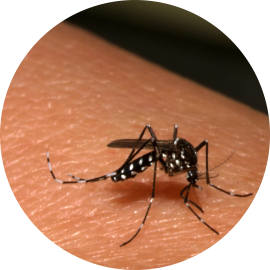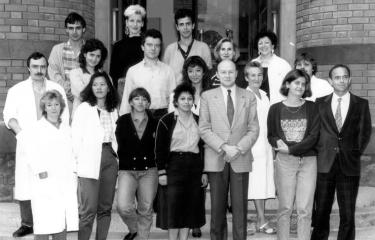Close to 70 different nationalities work alongside each other on the Institut Pasteur's Paris campus, and Anna-Bella has come all the way from Tahiti. She was born in Papeete, French Polynesia and lived there until the age of 18. This small paradise conjures up idyllic images but it is blighted by mosquitoes. Maybe that is why Anna-Bella became a medical entomologist specializing in mosquito vectors.
Anna-Bella Failloux is the eldest of five daughters. Her parents are the third generation of Chinese immigrants, who arrived in French Polynesia in the late 19th century. They ran a small shop in the town center and worked long hours. She approached her studies with this same work ethic. She was educated at Catholic schools in Papeete but when she finished high school, she had to leave the island to continue her education.
She won a scholarship and left Tahiti for the first time alone to study plant physiology at Paul Sabatier-University in Toulouse, France. "I have wonderful memories of the years I spent in Toulouse and at the university but boy was it cold in winter!"
Five years later, she gained a post-graduate diploma in plant parasites – pests that include insects. When her scholarship ended, Anna-Bella returned to French Polynesia and found a position as an entomologist at the Institut Louis Malardé in Papeete. At the same time, she wrote her doctoral thesis on Wuchereria bancrofti, a roundworm that is transmitted by the Aedes polynesiensis mosquito and causes a disease called lymphatic filariasis. This disease can develop into a serious form known as elephantiasis. At the time, it affected 8% of the Tahitian population and 40% of locals carried the parasite.
Post-doctoral studies in Paris
Anna-Bella was already familiar with the Institut Pasteur as she had spent three months there in 1988 for a medical entomology course taught by Professor François Rodhain. So, a few years later, it was only natural that she contacted him to continue her research in entomology and she applied for a postdoctoral fellowship in his unit. These two years were unpaid by luckily she obtained a research position in 1996. She worked on dengue and took a course in basic virology at the Institut Pasteur Education Center to develop her knowledge of virology.
Understanding and recognizing our enemies
Since then, Anna-Bella has headed up her own Arboviruses and Insect Vectors Unit. Mosquitoes are her specialty of course, particularly those that bite humans.

Aedes albopictus, vector mosquito of dengue and Chikungunya
Although 3,500 species exist in the world, only 15% of them need our blood,the others can quench their thirst on dogs, cattle, snakes and even crocodiles.
Two "urban" species live in close contact with humans – Aedes aegypti and Aedes albopictus, better known as the tiger mosquito. They usually forage and feed on sweet nectar but, during reproduction, females need protein so they bite and take their blood meals. Their saliva enters into contact with our bodies and that is where the trouble begins.
Networking and field work
Anna-Bella knows these two species well. They are vectors of diseases such as dengue, chikungunya, Zika and yellow fever.
In her laboratory, which has links with the Institut Pasteur International Network, she regularly receives samples of insects that are prevalent throughout the world and sometimes cause dangerous epidemics. With her team, she studies virus transmission mechanisms and how viruses develop and multiply in their hosts.
Over the last few years, her unit has been involved in many disease outbreaks. Our scientist is also just as at home in Parisian laboratories as in the field. Her various research projects have taken her to the atolls of French Polynesia in search of mosquitoes in crab burrows, and to South-East Asia to collect larvae from domestic breeding sites, such as discarded containers or tires filled with rain water. "I've even studied mosquito populations in the Ta Prohm temple in Angkor, Cambodia and in the Tijuca rainforest in Brazil, where I joined a yellow fever vector surveillance team!"
There are many reasons for outbreaks, and they are always closely linked to human activities. That is why we need to work in the field to study the causes, for example deforestation, uncontrolled urbanization or poor water management.
"To ask the right questions in science, we need to be aware of and observe many phenomena. And this takes time... If we try and work too quickly to get results, we may miss what we are looking for" she concludes.

Key dates in Anna-Bella Failloux's career
2008 - present day: Head of the Arboviruses and Insect Vectors group then unit at the Institut Pasteur
1998 – 2007: Research Associate (Infection and Epidemiology Department then Virology Department)
2000: Accredited to supervise research, Paris XII University, France
1996 – 1997: Research Assistant, Vector System Ecology Unit
1994 – 1996: Postdoctoral Fellow in the Vector System Ecology Unit led by Professor François Rodhain, at the Institut Pasteur

2016 yellow fever outbreak in Brazil: tiger mosquitoes are also capable of transmitting the virus





